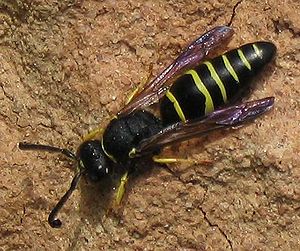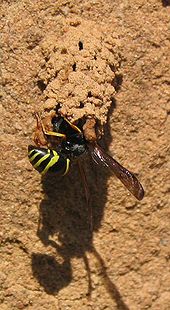Solitary wasps
| Solitary wasps | ||||||||||||
|---|---|---|---|---|---|---|---|---|---|---|---|---|

Solitary wasp |
||||||||||||
| Systematics | ||||||||||||
|
||||||||||||
| Scientific name | ||||||||||||
| Eumeninae | ||||||||||||
| Leach , 1815 |
The solitary wasps (Eumeninae) form a subfamily of the wasps (Vespidae) in the order of the hymenoptera . Of the approximately 3000 species worldwide , 82 live in Central Europe.
features
As with the rest of the wasps, the wings of the solitary wasps are folded lengthways when they are at rest. In contrast to the social wasps, i.e. the real wasps and the field wasps (also called paper wasps because of the nesting material ), the solitary wasps live alone, i.e. not eusocially in an insect state .
They are also called clay wasps after the preferred nest building material . For example, the genus of the potter wasps ( Eumenes ) builds brood cells from clay for their larvae. Other species dig cavities in clay or loess walls in which breeding chambers are created. Sometimes a faucet-shaped pipe is built from the excavated earth in front of the nest entrance.
Systematics
The subfamily of the solitary wasps is divided into 37 genera with around 312 species and subspecies in Europe . So far 67 species have been identified in Germany, for example:
-
Allodynerus
Blüthgen , 1938
- Allodynerus delphinalis ( Giraud , 1866)
-
Ancistrocerus Wesmael , 1836
- Ancistrocerus dusmetiolus ( Strand , 1914)
- Ancistrocerus gazella ( carapace , 1798)
- Ancistrocerus nigricornis ( Curtis , 1826)
- Ancistrocerus oviventris ( Wesmael , 1836)
- Ancistrocerus trifasciatus ( Müller , 1776)
-
Delta de Saussure , 1855
- Delta bicinctum ( de Saussure , 1852)
- Great clay wasp ( Delta unguiculatum Linnaeus , 1758)
-
Discoelius Latreille , 1809
- Discoelius zonalis ( tank , 1801)
-
Euodynerus Dalla Torre , 1904
- Euodynerus quadrifasciatus ( Fabricius , 1793)
- Pottery Wasps ( Eumenes Latreille , 1802)
-
Gymnomerus Blüthgen , 1938
- Gymnomerus laevipes ( Shuckard , 1837)
- Katamenes
-
Leptochilus Saussure , 1853
- Leptochilus alpestris ( Saussure , 1855)
-
Microdynerus Thomson , 1874
- Microdynerus exilis ( Herrich-Schäffer , 1839)
-
Pterocheilus Klug , 1805
- Pterocheilus phaleratus ( carapace , 1797)
-
Stenodynerus
- Stenodynerus dentisquama ( Thomson , 1870)
-
Symmorphus Wesmael , 1836
- Symmorphus bifasciatus ( Linnaeus , 1761)
- Symmorphus murarius ( Linnaeus , 1758)
literature
- Christian Schmid-Egger: Identification key for the German species of solitary folded wasps (Hymenoptera: Eumeninae). In: Volker Mauss, Reinholdreiber : Identification key for the folded wasps (Hymenoptera: Masarinae, Polistinae, Vespinae) of the Federal Republic of Germany. 2nd Edition. German Youth Association for Nature Observation , Hamburg 1995, ISBN 3-923376-17-0 , separate page counting.
Web links
Individual evidence
- ↑ Eumeninae. Fauna Europaea, accessed June 4, 2007 .

